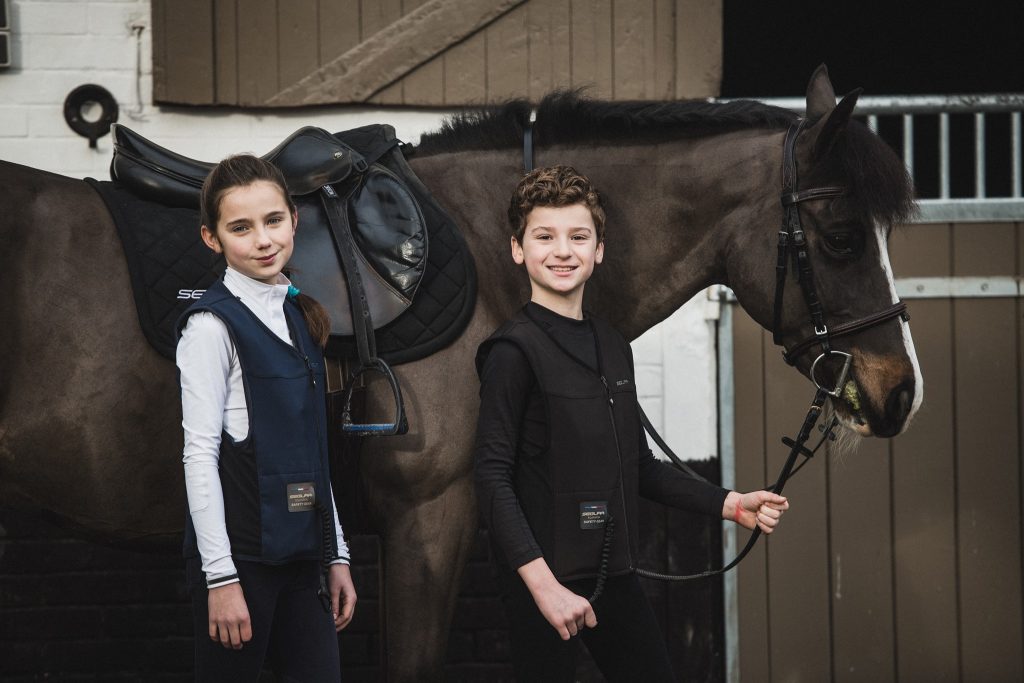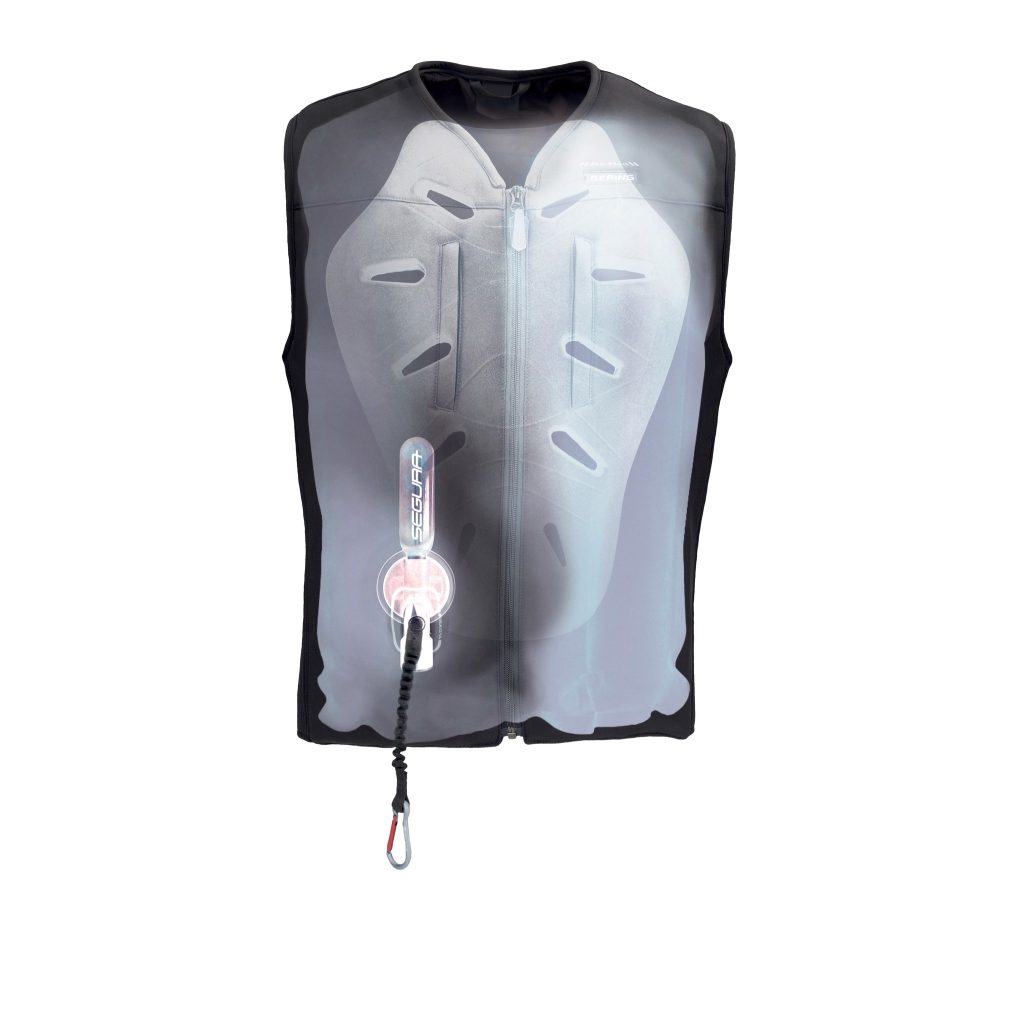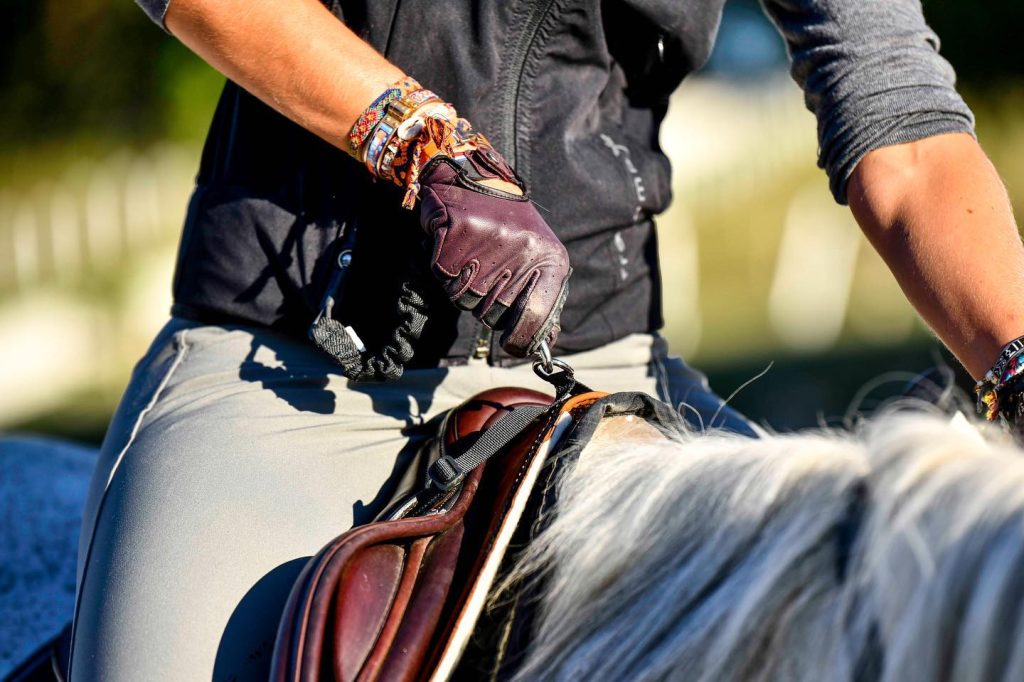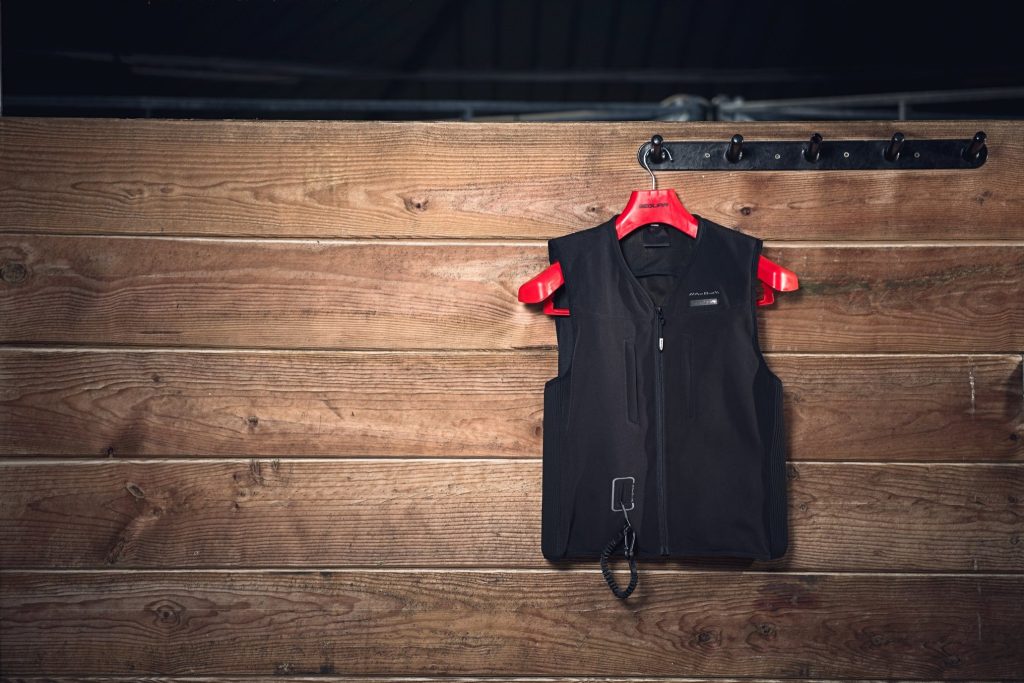More and more riders are thinking about the airbag vest. The level of protection it offers combined with the comfort and freedom of movement enjoyed by the rider is its main asset. Designers were inspired by the safety accessories used for motorbikes from the end of the 1990s and adapted them to the equestrian field just before 2010.
The airbag vest is a real technological innovation that protects many areas of the rider’s body in the event of a fall. It is meant to protect: the abdomen, chest, neck, shoulders, back and spine. In the airbag vest there is an integrated gas cartridge and a cord that attaches to the saddle. In the event of body separation between you and your horse the vest will automatically inflate within seconds by releasing CO2 under high pressure. Be careful to remove the strap when you go downhill at the end of the session!
The Airbag vest is a “passive” protection which offers a great freedom of movement, the protection intervening only in case of a fall.
There is no classification of the level of protection of airbags.
There are two types of Airbag vest, one is worn over any clothing only as long as the other can be worn under compatible clothing.
For the former, it is important to wear the airbag vest over all your clothes to ensure optimal inflation. For example, if it is underneath your incompatible coat, you risk tearing it if you fall and making it less effective.
Most of the vest combine ergonomics, comfort and design. They are an optimal protection during your trainings, your leisure activities or during your competitions. Many brands offer compatible clothing to blend your airbag into your outfit (competition jacket, down jacket, vest, etc.).
In order for the vest to maintain its effectiveness it’s important to store it (especially the cartridge) at room temperature and to check its condition. It should not have any holes or tears. The cartridge must be replaced after each activation, with a cartridge of the same brand as your airbag.
How do I choose the size of my airbag vest ?
You should choose a vest that is perfectly adapted to your body shape, it should be neither too big nor too small. If it’s too small, it can be dangerous when triggered; if it’s too large, it can become ineffective.
The size depends on the model you choose. Whether you opt for a waistcoat that is worn close to the body or not.
An Equithème “Air” vest is worn over clothing. Make sure you can fit a fist under the waistcoat.
If the waistcoat is close to the body (ex: SAFEFIT vest), it can be covered with an airbag compatible garment only. As the vest inflates outwards, there is no risk of compressing the rider’s body.

How does the CO2 cartridge work?
The cartridge contains supercharged CO2 which is essential for the operation of the airbag. When the contact between the rider and the horse is broken, the cord releases the firing pin which pierces the cartridge and releases the CO2. It instantly inflates the waistcoat membrane. The cartridges have a validity of 5 years, beyond that it is imperative to have it checked by checking the weight.

How to choose the CO2 cartridge?
First of all, we advise you to use the cartridges of the brand of your waistcoat and then choose the capacity according to the size of your waistcoat. First of all, we advise you to use the cartridges of the brand of your waistcoat and then choose the capacity according to the size of your vest.
If you choose the wrong cartridge, the vest may become ineffective. For example, if it is too big, your vest could burst. In addition to the different capacities, the cartridges have different steel thicknesses. The firing pins are designed to pierce the thickness of cartridges of the same brand.
To help you, the type of cartridge is often mentioned on the waistcoat or on the instructions for use.
You can also visit our size guide to find the correct cartridge for your airbag vest.
Once used, dispose of them in a designated metal recycling bin.
How do I install my Airbag vest ?
The saddle tie is fixed on both sides in the two stirrup knives. This way you get a perfect balance of release in case of a fall on the left or right side of the horse. The strap is clipped onto the central ring and thus connects the saddle to the airbag.

How do I store my Airbag vest ?
It is advisable to store it on a hanger in a dry place away from moisture. It is not recommended to expose it to high temperatures (radiators, cars in the sun, etc.). Storage on a hanger protects the membrane and limits the risk of bending or cracking. Cartridges should be stored at temperatures between -20 and 50 degrees.

How do I maintain my Airbag vest ?
It is recommended that you have your airbag triggered at least once a year. If you have any problems using your airbag waistcoat, it is important to contact your dealer. Some brands offer an overhaul or repair service for the vest.
You can use a soft brush or a damp sponge and warm soapy water to clean your waistcoat.
Do not put it in the washing machine or tumble dryer.
– Do not iron it.
How do I reactivate my Airbag vest after it has been triggered?
After the fall, the membrane of your waistcoat is inflated and the cartridge is emptied of its CO2. To re-prime your vest, empty the air from the membrane, replace the cartridge with a new one and connect the trigger ball attached to the saddle.
The exact procedure for re-priming differs depending on the airbag model. It’s important to follow the instructions in the user manual provided with the waistcoat.

Standards: Protective vest must comply with European standards CE EN 13158. They are on the label of your vest.
The protective waistcoat provides torso and back protection in the event of a fall or impact. It protects the kidneys, the rib cage and the organs of the abdomen.
Often thicker than the back protector, it is made up of several layers of foam to absorb shocks. Due to the relative stiffness of the vest, it helps the rider to stand upright on the horse. It can be worn over a teeshirt, polo or jumper but under a winter coat.
For protective waistcoats, the level of protection is classified into 3 categories:
– Level 1: Minimum protection for professional jockeys. This level of protection has been designed to meet the weight limits that apply to jockeys in racing. It is not suitable for the level of protection required for equestrian activities which require a minimum of level 2 protection.
– Level 2:Protection appropriate for low risk activities. It corresponds to the minimum recommended for leisure equestrian activities, from the beginner to the expert rider, practising in a club or any type of equestrian activity.
– Level 3: Superior protection suitable for leisure riding and competition. It is also intended for people who work with horses and are at risk of being kicked. This is the level of protection required for riders practising carriage driving, eventing and Trec.
It is important to choose a waistcoat that fits as close to the body as possible so that it is effective. A vest that is too small may restrict your movement and breathing. Conversely, a vest that is too large will not be effective in the event of a fall.
Please note that a level 3 vest must be worn in cross country and marathon driving.
How do I choose the size of my protective waistcoat?
For optimal protection, it is important to choose a size adapted to the rider’s morphology.
For optimal protection, it is important to choose a size adapted to the rider’s morphology. It is necessary to measure the chest circumference, the waist circumference up to the navel and the back length from the base of the neck to the top of the coccyx. Some waistcoats are adjustable around the waist and chest.
It is imperative to get the back length right! If the waistcoat is too long, the rider will have difficulty sitting in the saddle. If it is too short, the protection of the kidneys and neck will not be effective.
How to maintain your body protector ?
It is not advisable to remove the foam inside your body protector. The outside of the body protector can be cleaned with a soft brush or sponge. You can use warm water and a mild soap.
- Store it in a well ventilated area.
- Do not expose to high or low temperatures.
- Do not store it in a place where it can be compressed and damaged.
Standards: the back protectors are subject to the EN1621-2 standard which corresponds to protective clothing against mechanical impact for motorcyclists.
Unlike the safety waistcoat, the back protector only protects the rider’s back. It usually consists of a layer of foam that softens in contact with the rider’s body heat. As a result, the rider’s movements are freed up for maximum comfort. As a result, the rider’s movements are freed up for maximum comfort.
They can be used in all equestrian disciplines with the exception of marathon driving and eventing competition and Trec.





